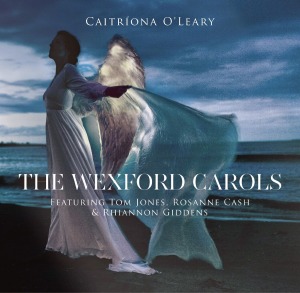Christmas music evokes the spirit and sublime essence of the season, and Caitriona O’Leary has captured all that is meaningful about the Yuletide in her new CD, “The Wexford Carols,” by restoring original tunes to the 17th century poems and singing them in her glorious voice.
Caitriona, the Donegal born singer known for her ethereal voice and for her group DULRA, became captivated by The Wexford Carols 25 years ago when she first heard Noirin Ni Riain singing them on her album, “The Darkest Midnight.” The story behind the carols is part of Ireland’s dark history: Written as poems in 1684 by Luke Waddinge, Bishop of Ferns, County Wexford, they were published in “A Smale Garland of Pious & Godly Songs.” They were an expression of the politics of the time, and specifically Oliver Cromwell’s 1649 Sack of Wexford, which left the Irish Catholic gentry disenfranchised. The people found solace in this poetry, and began singing them to popular melodies of the era. In 1728, Father William Devereux composed his own version of the carols, titled “A New Garland Containing Songs for Christmas.” There were originally 22 songs, but only 12 are still sung annually in Wexford as part of the 12 days of Christmas. They were passed down as all traditional Irish songs have been—from “mouth to ear to mouth, through the generations.”
“Indeed, it is fascinating how songs are kept alive like that,” Caitriona said. “And how they develop and change, even if only tiny bit by tiny bit over the centuries. You can sometimes see this in songs that have been passed down orally in other regions—they may have started off the same but through the inevitable personal nuances of different singers end up quite different indeed. Look at how ‘Barbara Allen’ is sung in England versus Appalachia versus how it was written down in 18th century Scotland!”
Caitriona’s captivation with the carols led to her 25 year journey researching the history, and then thoroughly and meticulously recreating the original melodies to the songs.
“I listened to recordings of the traditional carolers in Kilmore (as well as hearing them live) and I read every scrap of history I could find. I was very fortunate to be able to hold in my hands and peruse an original 1728 edition of Waddinge’s ‘Garland’ (the second edition) in The National Library (Ireland) and had access to the treasure trove that is the Irish Traditional Music Archives,” Caitriona explained.
Some tunes were easier than others to restore to the poems.
“In the case of ‘An Angel This Night’ it wasn’t so hard at all; Waddinge intended for all of his poems to be sung and beneath the title of each is the instruction ‘To the tune of…’ In this case the tune in question was ‘Neen Major Neel.’ While the tune with that title is no longer known, two other Waddinge poems (‘On St. Stephen’s Day’ and ‘Song of the Circumcision, New Year’s Day’) are also to be sung to ‘Neen Major Neel’ and are both still sung traditionally. I have made the assumption that this is the original tune. In other cases, the prescribed tunes have been a little harder to hunt down. But by trawling through old ballad books and dance books from the 17th and 18th centuries, I did find some that I think are right. Like, for example, ‘This is Our Christmass Day’ which is supposed to be sung to the tune of ‘Bonny-brooe.’ I reckon that Waddinge probably meant ‘The Bonny Broom,’ a popular 17th century Scottish song.
“I really love these texts, the wonderful contrast between the humble and the lavish expressed in fabulously rich, yet accessible language. The tunes are beautiful, too, and the fact that so much of the tradition has been kept alive by the folk is really wonderful. Apart from ‘The Ennisworthy Carol’ (which is quite well known, generally by the name ‘The Wexford Carol’), these songs are almost unknown outside the parish in which they are still sung. And there is not a huge amount of traditional Irish Christmas music in the general repertoire. That fact also made these songs all the more precious to me. Also, I lived in New York for many years, and while there Irish culture took on a whole new meaning for me. Sometimes it takes exile to strengthen ties (the old ‘absence makes the heart grow fonder’)!”
And how did her three co-vocalists come to be involved in the project?
“The producer of this record, the lovely Joe Henry, suggested Tom Jones and Rosanne Cash and also Rhiannon Giddens—whose star is rising very fast; she is a member of the Grammy-winning Carolina Chocolate Drops and the New Basement Tapes (a ‘supergroup’ that also includes Elvis Costello and Marcus Mumford). He had worked with all three in the past and thought they would be a good fit for the project—I think he was right! These three singers, along with the band of brilliant players, gathered in a circle around Joe and me in a former stable (that is now the Grouse Lodge Recording Studio) and gave their individual and collective artistic responses to the tunes as I sang them, and together we made this beautiful music.”
Beautiful. Stunning. Sublime. It takes more than one adjective to describe “The Wexford Carols.”
Watch the video of “The Angell Said to Joseph Mild:”
Visit Caitriona O’Leary’s website, where you can order the CD.

